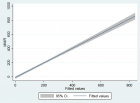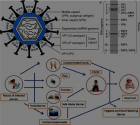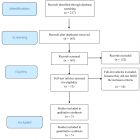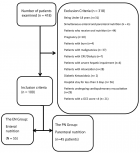About Beijing University
Beijing University
Articles by Beijing University
High water intake in preventing the risk of Uric Acid Nephrolithiasis: A systematic review and meta-analysis
Published on: 12th July, 2019
OCLC Number/Unique Identifier: 8199212116
Background: Hyperuricosuria, persistently low urinary pH, and low urinary volume are the main risk factors of uric acid nephrolithiasis. Epidemiologic studies suggest that high water intake is protective against the occurrence of symptomatic kidney stone events of all types. The objective of this systematic review and meta-analysis were to evaluate the effectiveness of increased water intake to prevent symptomatic uric acid kidney stone events.
Methods: Seventeen studies were identified for the meta-analysis. Analysis of Q and I2% statistics revealed that a high heterogeneity in 16 studies, thus, random effects model was used. Protective associations were identified for high water intake individuals (SMD=0.52 L; 95% CI: 0.19, 0.84; p=0.002); a significantly decreased relative super saturation of uric acid versus controls (SMD=-1.15; 95% CI: -2.00, -0.30; p=0.008). Risk factors including urinary uric acid excretion and pH were not significantly related to high water intake (SMD=7.32mg/d, 95% CI: -52.27, 66.91; p=0.81), (SMD=0.14; 95% CI: -0.02, 0.31; p=0.09), respectively. Further subgroup analyses revealed that urinary uric acid excretion was significantly decreased in healthy individuals (SMD=-36.23 mg/d, 95% CI: -65.14, -7.31; p=0.001) compared to stone formers (SMD=27.41 mg/d, 95% CI: -33.18, 88.01; p=0.38); urinary uric acid excretion was significantly decreased in routine water intake groups (SMD=-61.49 mg/d, 95% CI: -120.74, 12.24; p=0.04) compared to mineral water intake groups (SMD=44.50 mg/d, 95% CI: -18.30, 107.29; p=0.16); urinary pH was significantly higher in mineral water groups (SMD=0.13, 95% CI: 0.01, 0.46; p=0.04) compared to regular water groups (SMD=-0.00, 95% CI: -0.13, 0.13; p=0.98).
Results: A total of 129 patients had 150 internal jugular catheter insertions. The mean age was 51.4±15.2 years with male to female ratio of 1.5:1. All the patients had chronic kidney disease; about 80% had tunneled IJC and 96.9% of the catheters were inserted in the right internal jugular vein. Immediate complications were recorded in 10% and late complications in 34.9% of the procedures. The immediate complications were kinking of guide wire (2%), arterial puncture (1.3%) and difficulty in locating the internal jugular vein (1.3%) or tunneling (1.3%). The late complications were infection (12.8%), poor blood flow (9.2%), bleeding (5.5%) and spontaneous removal of the catheter (5.5%). There was no statistical significant difference in both immediate and late complication with age and sex.
Conclusion: This meta-analysis identified evidence that urinary uric acid excretion, volume, pH and relative supersaturation of uric acid can be altered with high water intake intervention, reducing the risk of uric acid kidney stones.
Experimental research on the mechanism of chemical energy conversion to light energy under thermal induction
Published on: 2nd March, 2021
OCLC Number/Unique Identifier: 8941328053
Since the discovery of glare illuminators, considerable efforts have been devoted to achieving a breakthrough of high light intensity on the order of magnitude. In this paper, we prepared strong flash blinding agents for the first time by using aluminum powder, oxidant, and adhesive as the main materials, and tris-(8-hydroxyquinolinato) aluminum (Al2Q3), triazoindolizine, or nano zinc oxide, etc. as electronic output brightener after mixing and granulation according to the developed formulation. It was discovered that the luminescence intensity was related to the thermal effect of the substance while the brightener only served as an auxiliary brightening effect to achieve energy non-destructive conversion. With the same formula, the luminescence intensities of glaze agents with ADN and potassium perchlorate as oxidants were slightly higher than that of ammonium perchlorate oxidant; the brightening effect of nano-zinc oxide was slightly higher than those of tris-(8-hydroxyquinolinato) aluminum (Al2Q3) and triazoindolizine. The luminescence intensity of the substance with a high thermal effect value was high, but the luminescence time was slightly short. Under identical conditions, the luminescence effect of nano-aluminum powder was obviously better than that of micro-aluminum powder with the highest luminescence intensity of 3.9 × 1010 ~ 1.9 × 1011 cd and the luminescence time of 39 - 48 ms. The effects of shell material and structure and the effect of heat-induced mode on the luminescence intensity were also investigated. The luminescence intensity of the glare agent with a high shell strength was high, but the luminescence time was slightly short. Moreover, the energy level of the brightener is excited under the induction of high temperatures, which leads to a blue shift to promote the chemical reaction of the material in a favorable direction. Finally, the optical radiation of the thermally induced high-temperature combustion system was analyzed from the aspects of thermal effect, combustion temperature, and chemiluminescence effect. A way to improve the optical radiation intensity of a high-temperature combustion system was proposed.

HSPI: We're glad you're here. Please click "create a new Query" if you are a new visitor to our website and need further information from us.
If you are already a member of our network and need to keep track of any developments regarding a question you have already submitted, click "take me to my Query."

























































































































































